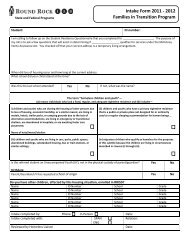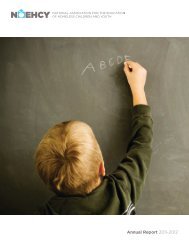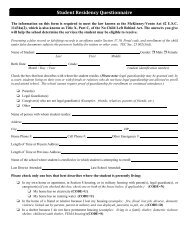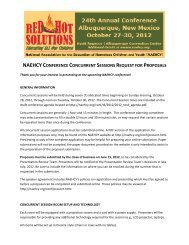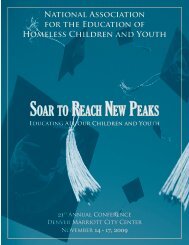The McKinney-Vento Act and Children and Youth ... - State of Michigan
The McKinney-Vento Act and Children and Youth ... - State of Michigan
The McKinney-Vento Act and Children and Youth ... - State of Michigan
Create successful ePaper yourself
Turn your PDF publications into a flip-book with our unique Google optimized e-Paper software.
(iii) children <strong>and</strong> youths who are living in cars, parks, public spaces,<br />
ab<strong>and</strong>oned buildings, subst<strong>and</strong>ard housing, bus or train stations, or<br />
similar settings; <strong>and</strong><br />
(iv) migratory children (as such term is defined in section 1309 <strong>of</strong><br />
the Elementary <strong>and</strong> Secondary Education <strong>Act</strong> <strong>of</strong> 1965) who qualify<br />
as homeless for the purposes <strong>of</strong> this subtitle because the children are<br />
living in circumstances described in clauses (i) through (iii).” 33<br />
Based on this definition, the <strong>McKinney</strong>-<strong>Vento</strong> <strong>Act</strong> applies to children <strong>and</strong><br />
youth who are “awaiting foster care placement.” <strong>The</strong> <strong>McKinney</strong>-<strong>Vento</strong> <strong>Act</strong><br />
does not define the parameters <strong>of</strong> the phrase “awaiting foster care placement.”<br />
In its Non-Regulatory Guidance, the U.S. Department <strong>of</strong> Education<br />
(USDE) does not define the term either, addressing the issue only briefly <strong>and</strong><br />
suggesting that “LEA liaisons should confer <strong>and</strong> coordinate with local public<br />
social service agency providers in determining how best to assist homeless<br />
children <strong>and</strong> youth who are awaiting foster care placement.” 34<br />
In the absence <strong>of</strong> a clear federal policy, states <strong>and</strong> localities have adopted<br />
different definitions <strong>of</strong> awaiting foster care placement. This report explains<br />
several different approaches to defining awaiting foster care placement, as<br />
well as policies <strong>and</strong> practices to implement the definitions <strong>and</strong> support<br />
the educational stability <strong>and</strong> success <strong>of</strong> children <strong>and</strong> youth awaiting such<br />
placement. Specifically, the report highlights policies <strong>and</strong> practices from the<br />
following jurisdictions:<br />
• Connecticut<br />
• Delaware<br />
• Massachusetts<br />
• Anchorage, Alaska<br />
• Ann Arbor, <strong>Michigan</strong><br />
• Fairfax County, Virginia<br />
• Minneapolis, Minnesota<br />
• Pima County, Arizona<br />
<strong>The</strong>se states <strong>and</strong> localities were selected in an effort to present a variety <strong>of</strong><br />
definitions <strong>of</strong> awaiting foster care placement, vehicles for establishing the<br />
definition, types <strong>of</strong> collaborations between education <strong>and</strong> child welfare<br />
agencies, <strong>and</strong> practical strategies for implementing the law <strong>and</strong> supporting<br />
the educational achievement <strong>of</strong> youth in foster care.<br />
Child welfare agencies<br />
also have legal<br />
responsibilities related<br />
to the education <strong>of</strong><br />
youth in their care. For<br />
example, Title IV-E <strong>of</strong><br />
the Social Security <strong>Act</strong><br />
requires agencies to<br />
keep education records<br />
as part <strong>of</strong> their written<br />
case plan, including<br />
names <strong>and</strong> addresses<br />
<strong>of</strong> educational providers,<br />
grade level performance,<br />
school records, <strong>and</strong><br />
assurances that the<br />
child’s placement in<br />
out-<strong>of</strong>-home care takes<br />
into account proximity<br />
to the school in which<br />
the child is enrolled at<br />
the time <strong>of</strong> placement.<br />
<strong>The</strong> child’s education<br />
record must be reviewed<br />
<strong>and</strong> updated as part <strong>of</strong><br />
case plan reviews, <strong>and</strong><br />
the child welfare agency<br />
must give a copy <strong>of</strong><br />
the record to the foster<br />
parent or foster care<br />
provider at the time <strong>of</strong><br />
each placement. When a<br />
youth ages out <strong>of</strong> care,<br />
the agency must provide<br />
the youth with a copy<br />
<strong>of</strong> his or her education<br />
records. (42 U.S.C.<br />
§675(1)&(5))<br />
Continued on page 16.<br />
Strategies for Improving Educational Outcomes through School Stability 15




